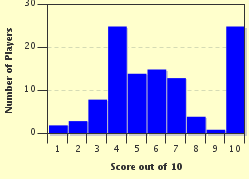Quiz Answer Key and Fun Facts
1. What causes fog or mist to form?
2. You have woken up in the morning to see that the ground appears to be covered in a cloud.
Can you tell me the difference between fog and mist?
3. It is a bright, hot, sunny day similar to what the weather has been for the past three days. There is a lot of high level cloud in the sky, sometimes known as a 'mackerel sky'. What type of cloud is this most likely to be?
4. Surprise! surprise! the weather forecast is for thunderstorms this afternoon. Which type of cloud creates the most thunderstorms?
5. Thunder can be heard in the distance. My friend assures me that if I count the seconds between seeing the lightning and hearing the thunder, it is possible to calculate the distance of the storm. Is this true?
6. If you are unfortunate enough to get caught outside in a thunderstorm, what is the best way of reducing your chances of being struck by lightning?
7. Wow! I have just seen an amazing phenomenon in the middle of a thunderstorm, a rapidly moving column of air was spiralling up into the sky. What type of thunderstorm produces the most tornadoes?
8. We all know of Tornado Alley in the USA. Which country in Europe has the most reported tornadoes per square mile of land area?
9. The damage caused by tornadoes used to be measured using the 'Fujita (or Fujita-Pearson) Scale'. This was superseded in 2007 by the 'Enhanced Fujita Scale'. How many levels of intensity could be indicated using the original 'Fujita Scale'?
10. I have walked out into the garden and noticed that all of the glass in my greenhouse appears to have been broken. Which meteorological phenomenon associated with tornadic thunderstorms may have caused this?
Source: Author
DaveH1960
This quiz was reviewed by FunTrivia editor
crisw before going online.
Any errors found in FunTrivia content are routinely corrected through our feedback system.

